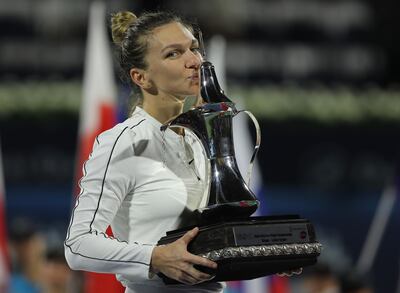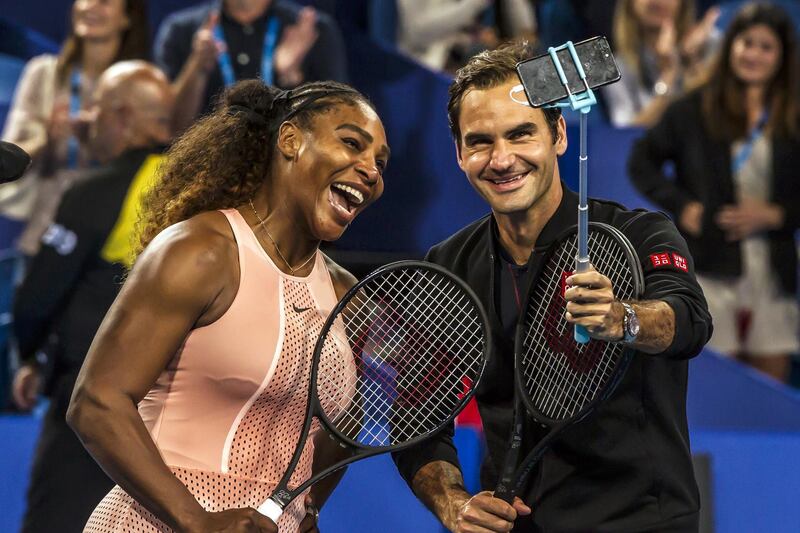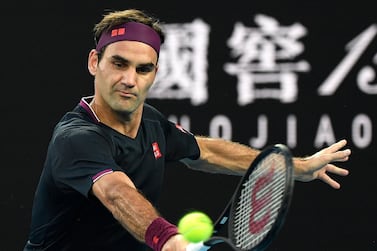Acclaimed coach and former top-25 player Darren Cahill believes a merger between the men’s and women’s tennis tours could lead to a much healthier state of the sport, and suggests that bringing the ITF as well under the same umbrella would prove even more beneficial.
Tennis currently has seven different stakeholders – the four Grand Slams, the ITF, the ATP and the WTA – and those different entities often have opposing interests.
Cahill, who is the coach of two-time Grand Slam champion Simona Halep and previously worked with the likes of Andre Agassi and Lleyton Hewitt, laments the current fragmented structure of tennis and imagines a far more united scenario that combines the ATP, the WTA and the ITF.
"This leads us more towards a commissioner in tennis," Cahill told The National just hours before Roger Federer took to social media to express his hopes of a merger between the ATP and the WTA.
“Let’s say hypothetically the four Slams remain as they are, but then you have the ATP, the WTA and the ITF all rolled into one, and that means you can appoint a commissioner of tennis that oversees the men’s and women’s tours, Fed Cup, Davis Cup, the Olympics and also the smaller events that are under the ITF and also under the WTA. That person and that organisation would have enormous power.
“And I think, hypothetically, it would be a pretty good position for a tennis player to be in, because you know that every single decision being made is made in the best interest of the game.”
Cahill’s experience coaching male and female players to the world No 1 spot, as well as his role as a TV commentator and analyst, gives him a well-rounded view of the sport.
The Australian believes merging the tours has numerous advantages, like having more negotiating power with the Grand Slams, or with broadcasters, while also making things less confusing for fans.
“At the moment, as a fan of tennis, if you want to try to follow tennis, whether it’s Davis Cup, Fed Cup, the WTA, the ATP, smaller events, there are so many different platforms a fan has to subscribe to and it’s confusing,” he explains.
“Social media becomes much easier as well, if the tours are merged. Instead of competing against each other for a social media space, that becomes all one.

“One set of rules; at the moment there are different rules on the WTA tour compared to the ATP tour, one set of rankings as well, which would make everything much easier to understand.
“Even for us that live on the WTA tour, it’s not easy to understand how the tour works, whereas the men’s tour is much easier. We know your 1000s, the 500s, the 250s and how the rankings work, it’s much more complicated on the women’s tour, so this would simplify everything.”
Of course merging the tours is no simple matter and Cahill acknowledges that. The ATP and WTA have different calendars and not all combined events offer equal prize money.
Would a unified tour have men and women at every tournament? Will combined tournaments all agree to offer equal prize money? Will the men be happy to be on equal terms with the women across the board?
“At the moment the men command a little more at the negotiating table when we’re talking about TV rights. Ratings are interesting because it depends what zone you’re in, as to who rates better. I know Serena Williams in the US rates amazingly well and she’s up there with Rafa and Federer,” says Cahill.
“But I think tennis is past that. We as a sport, because of the likes of Billie Jean King, and Chris Evert and Martina Navratilova and what went on all those years ago to form the WTA and the fight for equal rights and the fight for equal prize money, this current generation of player is brought up thinking that that’s it, this is the way tennis is heading, and this is the way we play and this is what we expect.
“So I think, to a large extent, everyone will take this. Obviously there would be some resentment from some male players but the majority I think would see the benefits and understand that this is the right thing to do.”
Having both tours under one banner would mean consolidating resources, which could lead to loss of jobs, but the money saved can be funnelled back into the sport, making it more sustainable for a larger pool of players.
“It’s more about how do we make sure that this game remains to be healthy and continues to grow?” Cahill added.
“Back when I was playing [in the ‘80s and ‘90s], I reckon the game serviced about 150 players. If you’re ranked 150 in the world, you could survive. It’s still the same now. If you’re ranked outside the 150 in the world you’re struggling to pay your way and that’s not right. Because the amount of prize money that’s in the game now is much more than it was years ago.”
Cahill feels the current hiatus due to the coronavirus pandemic provides a chance for the sport to reset, and rework its structure.
The lower-ranked players have been hit hard financially during the tours’ suspension, and many are considering leaving tennis as a result.
The top 100 men, spearheaded by world No 1 Novak Djokovic, have proposed a plan to contribute to a relief fund dedicated to those ranked between 250 and 700. The ATP, as well as the four majors, are also expected to make their own contributions.
“Hopefully this [difficult period] is a wake-up call for the tours that they’ve got to do better,” the 54-year-old Australian explains.
“The fact that the players felt responsible to start this player relief fund should be a shining example for the ATP, WTA and ITF is, ‘hey guys, you haven’t done a good job here’.
“The players shouldn’t really be doing this, they shouldn’t have to do this. The fact that nobody is earning money in tennis at the moment, yet the top 100 players are dipping into their own pockets to send money down through the ranking system, it’s not right that the ATP, WTA and ITF have put the players in that situation.
“Good on the men, especially Novak, for starting this up. Good on the male players for backing it. I hope the WTA players back it as well.
"I know the WTA is asking the female players if they’ll do something similar to what Novak is suggesting. And I can tell you Simona [Halep] has already agreed to do that.”







